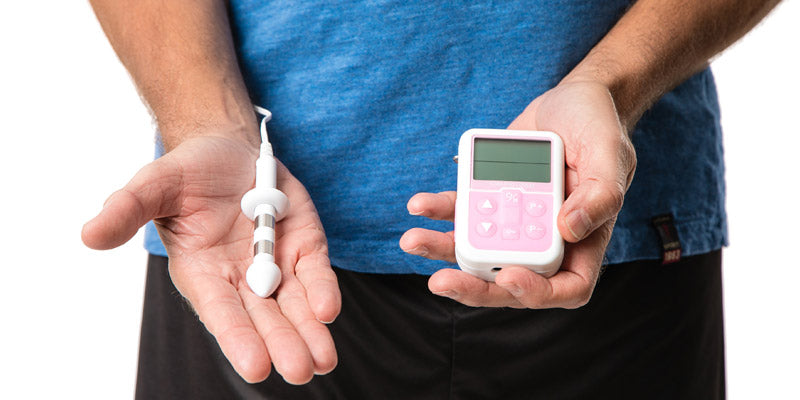Pelvic floor trainer for the treatment of incontinence

Improvement of the quality of life and regaining flexibility by strengthening the pelvic floor muscles with incontinence problems for men and women with certified medical products from axion
Our most popular electric pelvic floor trainers
-
Pelvic floor trainer set for women, including vaginal probe
Regular price €109,95Regular priceUnit price per -
Pelvic floor trainer set for men, including anal probe
Regular price €109,95Regular priceUnit price per
Why a pelvic floor trainer makes sense
The pelvic floor or the pelvic floor muscles is a very important part of the body and fulfills many functions, which is why pelvic floor training makes sense for both women and men.
Often this is not properly perceived because everything is working properly. The importance of a strong pelvic floor only becomes apparent when functional ability decreases and problems such as incontinence occur.

The function of the pelvic floor muscles
The pelvic floor muscles are located in the lower part of the pelvis and form the floor of the pelvic cavity (the pink area of the graphic).
It consists of several layers of muscles that run between the pubic bone, the ischial bones and the coccyx and support the internal organs such as the bladder, intestines and uterus.
The muscles of the pelvic floor are interconnected like a network and work together to maintain bladder and bowel continence, support pelvic stability, and regulate sexual function.
Pregnancy, childbirth, obesity, prolonged sitting and muscle loss with age can weaken the pelvic floor, which can lead to the problems listed below.
Limitations in everyday life
An electric pelvic floor trainer for at home can support and remedy the following problems:

Stress incontinence
Stress incontinence mostly affects women. Depending on the degree of severity, this can lead to an unintentional loss of urine during physical exertion or at rest.
Coughing, sneezing or lifting heavy weights ( 1st degree ) increases the pressure in the abdomen, which in people suffering from stress incontinence leads to involuntary leakage of urine. In the 2nd degree there is an involuntary loss of urine even with slight physical exertion such as walking or climbing stairs and in the 3rd degree even when standing or lying down.
Urge incontinence
Also often referred to as overactive bladder or bladder weakness. There is a sudden and uncontrollable urge to urinate, which forces the person to go to the toilet immediately. Bladder control is impaired.
Fecal incontinence
Fecal incontinence is usually triggered by an impairment of the sphincter , e.g. B. after an operation of the sphincter, after a birth with perineal tear or also with age-related decline of the musculature.
Here, too, a classification into degrees of severity can be made, from the uncontrolled discharge of intestinal gas ( 1st degree ) to the uncontrolled discharge of solid stool ( 3rd degree ). If faecal incontinence is present, urinary incontinence often occurs as well.
Erectile dysfunction
Most men are not aware that there is a connection between potency and the pelvic floor muscles. In order to get an erection sufficient for sexual intercourse and to maintain it long enough, among other things, strengthened pelvic floor muscles ensure.
Regular pelvic floor training can reduce the risk of erectile dysfunction or erectile dysfunction and increase potency.
How does an electric pelvic floor trainer with stimulation current work?
Pelvic floor training with EMS strengthens the muscles using the appropriate vaginal or anal probe. The various programs of the EMS device gently train the pelvic floor muscles and, if used correctly, have no side effects.
A pelvic floor trainer works according to the principle of an EMS device, i.e. the muscles are made to contract by gently emitting electrical impulses. With regular use, this can lead to strengthening of the pelvic floor muscles. A pelvic floor trainer also helps you to specifically feel the pelvic floor muscles.
Frequently asked questions
FAQ pelvic floor training
Can an electric pelvic floor trainer help relieve incontinence and other pelvic floor problems?
Yes, with electrical stimulation devices you can strengthen the muscles that are needed for urination or bowel movements and thus ensure a healthy pelvic floor.
What are the contraindications of an electric pelvic floor trainer?
There are circumstances with pelvic floor trainers where you should not use them or only use them in consultation with your doctor.
As an analogous alternative, you can do classic pelvic floor exercises, such as the well-known Kegel exercises. We have put together pelvic floor exercises for women and pelvic floor exercises for men for you.
The contraindications are:
- – For infections in the vaginal or rectal area
- - If you have a pacemaker
- – Immediately after childbirth (You can start pelvic floor exercises similar to post-natal exercises about 6-8 weeks after childbirth)
- – hemorrhoids
- – Should you use an IUD for contraception
- – In the event of an overflow bubble
- – When the entire pelvic floor is denervated
- – Piercings or implants in the pelvic floor area
- – If you have recently had prostate surgery (you should wait until everything has healed before doing pelvic floor exercises)
How often should you train your pelvic floor?
The pelvic floor can be trained every day. Continuous training is important for training success. However, if you feel a pull or pain after training, it is better to take a day off.
How long does it take to train the pelvic floor?
This varies from person to person and therefore cannot be answered in general.
The period can last from one month to half a year, depending on how well the pelvic floor was already strengthened or weakened.
How do I find my pelvic floor muscles and how can I train them
To find your pelvic floor muscles, you can try stopping or delaying the stream of urine when urinating. The muscles you tense are your pelvic floor muscles.
However, it is important not to do this exercise on a regular basis as it can put stress on the bladder and urinary tract. Instead, you can use another method to feel and train your pelvic floor muscles:
- Sit or lie comfortably, relax your body, and breathe in and out deeply.
- Imagine tensing your pelvic floor muscles as if you are stopping the flow of urine. Be careful not to tighten your abs, glutes, or hamstrings.
- Hold the tension for about five seconds before letting go and relaxing. Repeat this about ten times in a row.
- If you're having trouble finding the right muscles, you can insert a finger into the vagina or anus and try squeezing the muscles around the finger.
It is important to do pelvic floor exercises regularly to strengthen muscles. The exercises can also be done standing, sitting or lying down, whichever is comfortable for you. There are also special aids, such as electric pelvic floor trainers, that can help strengthen the pelvic floor muscles.
Can the pelvic floor muscles be stimulated with electrodes instead of a probe?
Yes, you can also use electrodes. (For placement, please refer to the instructions for use).
However, we recommend using a probe.
Is pelvic floor training as important for men as it is for women?
Yes, because the pelvic floor muscles are the same in women and men, although they are structured somewhat differently due to the different anatomy.
What exercises are there to strengthen the pelvic floor?
There are a number of exercises for pelvic floor training without aids such as electrical stimulation devices, including the pelvic raise, the candle and the famous Kegel exercises.
We have put together pelvic floor exercises for women as well as pelvic floor exercises for men.
Are there any specific pelvic floor training tools I should use?
There are a number of tools to train the pelvic floor. There are vaginal balls or exercise devices with electrical stimulation.
The exercise devices for the pelvic floor, which work with stimulation current according to the EMS principle, use a probe made of hygienic stainless steel or gold for allergy sufferers, which is inserted into the vagina or anus. The silicone vaginal balls are inserted into the vagina and the movement or exercises stimulate the muscles of the pelvic floor. With an EMS exercise device, you can do the training comfortably on the couch without having to move. Electric pelvic floor trainers are also used by midwives, and both types of pelvic floor training can bring positive results.
Why are the muscles on the pelvic floor important?
The most important functions of the pelvic floor muscles include:
- the support of the pelvic organs (rectum, bladder, uterus, ovary, vagina, prostate)
- sphincter support
- strengthen the muscles of the body during exertion
-

-
We are happy to help
Do you still have questions about pelvic floor training? Our trained consultants are there for you!
-
Give us a call:
+49 (0) 7152 - 353 911 - 0
Mon-Fri, 09:00 - 17:00
Send us an email:
customerservice@axion.shop







